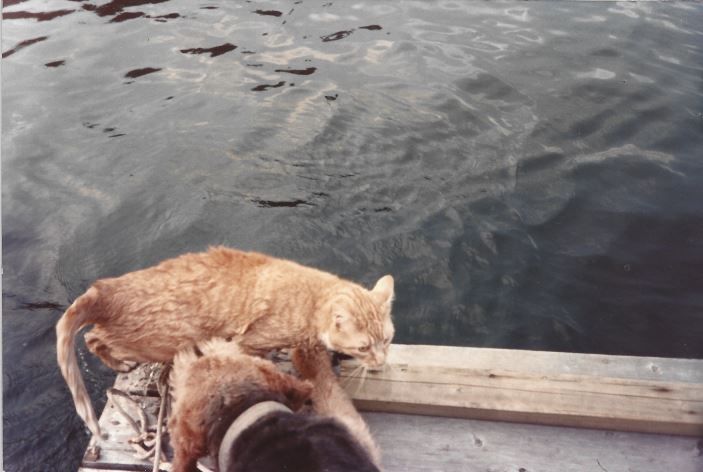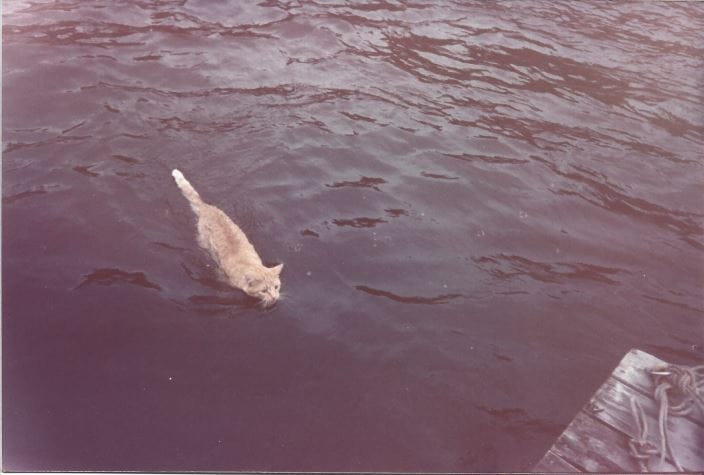GATITO: A Tale of a Real River Rat Cat
by: Melinda Comstock & Martha Grimes
A Tale Told by Martha Grimes and Melinda Comstock
Gatito’s story began in 1988. He was born in the boatyard of a local marina in Alexandria Bay. The yellow and white kitten proved even then that he was a survivor, under the care of several employees who provided food and make-shift shelter for him during the summer months.

As the season moved on to fall and the inevitable closing of the marina until Spring approached, attempts were made to catch him, but the feral cat was elusive and unwilling to be captured for its own good.
December blew in on a gust of cold wind and snow. One of the men was finally able to scoop him up one day and deliver him to the Redwood home of Melinda and John Comstock, and his soon to be new, extended family. Gatito, the feral cat who had never known human hands before, immediately curled up in a cozy chair and probably said, “I’m home.”
His seven feline brothers and sisters, and two Airedales did not seem to notice one more whiskered face when the multiple food bowls were lined up at dinner time.
A life-changing event occurred in the spring of 1990, when the Redwood home was sold and construction began on a new waterfront home in Densmore Bay, Wellesley Island. The Comstock family, including the two Airedales, Dandelion and Wooly Bear, and eight cats, Topaz, Tickenwacken, Raggle Taggle, Rapunzel, Rebok, Pollux, Caster, and Gatito moved temporarily to their summer cottage on island 105b, also known as Isle Ilene, in Canada. Home was now a small rocky island located near the cut at the head of Grenadier Island.
Moving and settling in was accomplished in one weekend. The Comstocks then resumed their typical Monday morning routine of preparing to leave for work. Instead of driving the highway in their respective vehicles, they set out in their boat, a 16ft Starcraft with a 30 Hp Evinrude.
John worked as a salesman at O’Brien’s Boat Rental and Sales and Melinda taught first grade at Alexandria Central School.
When they returned to Isle Ilene at 4:30, they were greeted with great enthusiasm by a medley of tail wagging, ankle-winding cats and dogs, except for one. Gatito was nowhere to be found. The nooks and crannies of the cottage were searched, tree branches were scrutinized, but there was no sign of the missing Gatito.
As dusk was approaching, a faint meowing drifted across the open water between islands.
Unbelievable! There was Gatito, sitting on the shore of Little Grenadier, across the 120 ft. channel from Isle Ilene. John Initiated a rescue mission to bring him home.
The daily swim continued for the next three days, at which point, his parents decided to challenge his behavior by ignoring him (but never to abandon him.) True to form, as the sun set, Gatito arrived on the distant shore, expecting a taxi to pick him up. When no boat arrived, he eventually slipped into the water, swam across the channel, and climbed onto the dock. The Airedale, Dandelion, attempted to assist, but he preferred to do it himself.
From that point on this became the cat’s routine. He swam to Little Grenadier in the morning and returned in the evening. Each summer evening the family gathered on the dock to watch the swimming cat make his return. He evidently employed his tail as a rudder to manage the swift current between the islands. He also chose the rocks for a less strenuous entrance and exit.
The swimming cat soon earned an international reputation as more people heard the story. Friends in Rockport, Lansdowne, and on Grenadier Island marveled at this amazing feline feat. Jeanne Snow, editor of the Thousand Island Sun, wrote a feature article that carried the tale to readers on both sides of the River.



The hazy days of summer passed and Gatito continued his daily swim. Many theories were voiced by friends and family as to what caused this unusual behavior in a species of animal otherwise programed to avoid wet paws at all costs. Melinda’s brother-in-law, Hunter Grimes, postulated (as only he could do), that it was obviously a manifestation of the Malthusian Theory, sometimes erroneously referring to lemmings who allegedly jump from cliffs into the sea when their colonies are over-populated. In plain English, he told Melinda she had too many cats on that small island.

Labor Day arrived, the new house was not yet finished, and Melinda had to return to school the next day. That night Gatito did not return. A search of Little Grenadier ensued, but there was no sign of the small yellow cat.
Making the trip in the early dawn hours, with the weather changing daily, did not seem as much fun and exciting to Melinda as it had in the late Spring and early Summer. She was arriving early enough to shower and dress at her parents’ home before going to school, and then there was the trip back to the island, as the days got shorter and cooler. Eventually, she moved in with her parents and John remained on the island to care for the cats and dogs. Each evening he faithfully got in his boat and cruised the shorelines of nearby islands, calling Gatito’s name.
Moving day to their new home took place in October. Once again, they packed up their belongings, crated the cats, leashed the dogs, and moved, with no news of Gatito’s fate. It was most likely that the fearless swimming cat had become the victim of a large pike, or a speeding motorboat. There was still a lingering hope for a miracle. The word was out to Canadian neighbors to keep an eye out for a lost yellow tabby, named Gatito.
By mid-November, everyone was settling into the new home, when Melinda received a phone call that there was a possibility that Gatito was alive and well. Local River Rats on both sides of the River often communicated by CB Radios. The chain of calls began in Canada. Ralph Hodge called Don Dingman, who called Ernie Mance, who in turn called the Comstocks. Gatito may have moved into a barn at the Ralph Hodge farm on Tar Island.

Being a true River Rat himself, John still had a boat, his beloved Crestliner, in the water. He set out the next day for Tar Island and the Hodge Farm, armed with a cat carrier and a can of tuna fish. The legend was alive. He was healthy and happy, doing very well in the barn.
Upon arrival at his new home, there were hugs, kisses, sniffing, and nose rubs from all of the family awaiting his return. According to Gatito’s response, it was just another day.
Sequel:
During the summer of 1993, the Comstocks had an opportunity to rent their home to friends of their neighbor. The family was now made up of Melinda, John, seven cats, due to the loss of one of the eldest cats, and two Airedales. The bags were packed, and the crates were loaded for the return to Isle Ilene to spend July and August.
Gatito immediately picked up his odd habit of the daily swim to Little Grenadier Island. And then by mid-August, he got wanderlust again. John and Melinda did daily searches along nearby islands, to no avail. By the time school started again, there was still no sign of Gatito. Mom, Dad, six cats and two dogs returned to Densmore Bay, not knowing what had happened to Gatito.
Just as before, the CB radio chain was activated in mid-October to bring the news there was a yellow cat living in Ralph Hodges barn on Tar Island – again. Once again, John made the trek to bring the vagabond home.

The River Rat Cat failed one more trial run to the island when he was instantly up to his old tricks. He was immediately re-crated, returned home, and he never set a paw in Canada again.
By Martha Grimes and Melinda Comstock
Melinda Service Comstock was born and raised in Alexandria Bay, the eldest of three children. Her years as an Educator at Alexandria Central School included assignments in Kindergarten, Pre-First Grade, First Grade and Jr. High Spanish. A longtime member of the Board of Trustees of the Alexandria Township Historical Society, she served as President, Treasurer, and volunteer. She resides with her husband, John Comstock, on Wellesley Island with Pumpkin, the cat that thinks she's a dog. (another story)
Martha Grimes was born and raised in Alexandria Bay. She and her late husband Hunter raised a son and daughter to love and appreciate the River as much as they do. During her career as an educator, Martha taught various Primary Level grades at Alexandria Central School. Since retiring she has been actively involved with the Alexandria Township Historical Society and the interpretation of the Cornwall Brothers Store & Museum, in Alexandria Bay, NY.
[Editor's Note: Melinda and Martha are sisters. I met Melinda during the summer of 2022 while I was a guest speaker at the Cornwall Brothers Store and Museum. Melinda told me about the cat and I immediately asked for this story. We can never keep the dogs out of the water, and I have often thought that a cat would be so much easier. Now I am not so sure.]






Please click here if you are unable to post your comment.